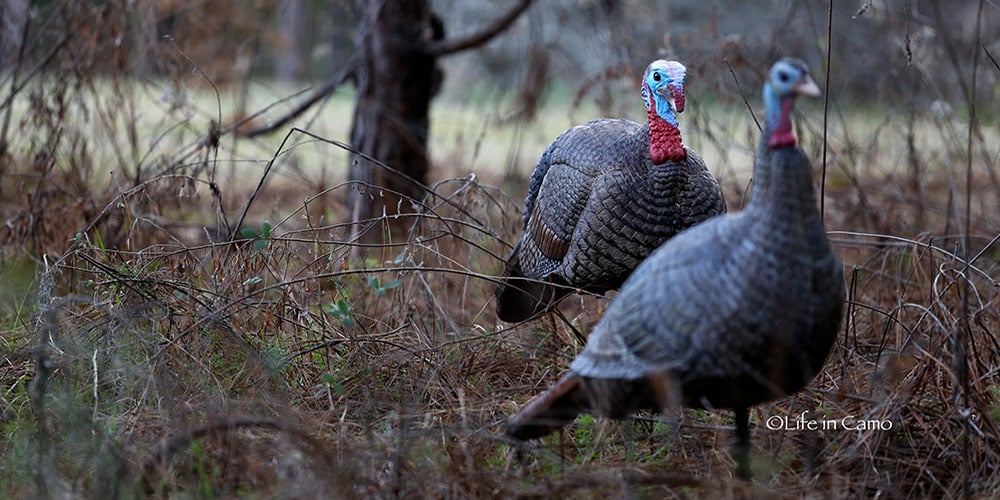Last Updated on
Any turkey hunter would agree that being a successful hunter takes more than average calling and a double dose of patience. Even some of the best turkey callers in the industry have sat countless hours afield with impeccable calling and still were not successful in harvesting that wary trophy tom.
A turkey hunter can have top of the line gear, sporting the season’s hottest shotgun, turkey choke and turkey load ammo, using the newest turkey vest on the market, wearing the most popular spring camo line, employing various award winning calls of all varieties and still not be successful in the turkey woods. Any hunter who has spent numerous hours, days, weeks or even months in the turkey woods chasing toms knows that woodsmanship, concealment, decent calling and patience are all skills to possess for success. Much focus is on calling and it is true that knowing when and what call to use is detrimental to enticing a tom and can be the difference between drawing in a tom to your set-up or having him hang-up and eventually lose interest. With all the focus on calling, often one critical component and invaluable aid that can greatly increase the odds of a successful hunt is overlooked or misused–the use of decoys to entice mature toms into a hunting set-up.
Attraction and Distraction
There are two reasons for using turkey decoys: attraction and distraction. The attraction component is pretty self-explanatory, just as it is in human nature. Hen decoys attract toms by engaging their hormone-induced mating drive; whereas a jake/tom decoy engages the competitive and usually aggressive reaction by instinct. Decoys can be very effective in luring toms from a long distance if the tom is able to see the decoy. Also, just as crucial is knowing how and where to set up the decoys to be the most effective. The distraction component gives the hunter a small advantage to the keen eyesight of turkey. When a tom is working its way to a decoy, its focus is on the decoy itself and the tom is less likely to see small movements by the hunter. However, placing the decoy in direct line of sight is not always productive unless you can be motionless, have good cover in front of you or if you or are in a blind. You should also keep in mind that if the tom is being coaxed and coddled by your calling and is looking for a hen decoy he cannot see, the tom is likely to bust any small movement that you make. The goal is to set the decoy up in a manner that will not place the tom in your direct line of sight so that he will keep his attention on the decoy allowing for subtle movement to go undetected and placing the bird at a distance and angle that will allow an ethical shot for the harvest.
Quality Turkey Decoys
Knowing what to look for in a good turkey decoy is important to the effectiveness of your decoy use. It is imperative to know that the upfront investment may be a little more but in the long run, the splurge will prove more effective in saving you the time and the disappointment of unsuccessful hunts. After all, time is money if you think about the time away from your family or your job, fuel expense to get to the hunt, the cost of ammo and, for many, the cost of a hunting lease or club membership. Turkey have impeccable eyesight and although they can be fooled by an economy foam turkey decoy, they are not going to stay around long or come in the last crucial 10-yards if they feel wary about the decoy. Always look for quality, realistic looking decoys that resemble the colors, size and look of a real turkey. When possible, adding real feathers, a real tail fan or a beard adds realism to decoys.
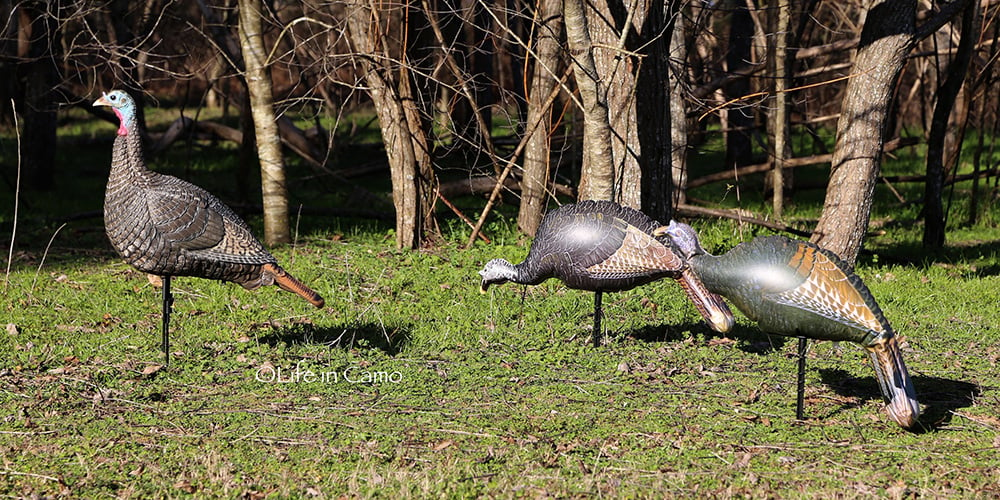
Just like humans, turkeys have a body language to clue other birds as to their current state. There are several brands of turkey decoys, which come in an assortment of poses to use in a variety of situations. The varieties of decoys available are the feeding bird, sentry/alert bird, loafing/walking bird; which are available in hen, jake or tom. The breeding hen, full-strut and half-strut tom or jake, dominant jake or submissive jake. There are even specialty decoys such as the wounded tom decoy, which makes perfect sense because usually other toms will run in and attack a downed tom/jake. On most loafing/walking hens the stake can be removed and the decoy can be placed on the ground to simulate a breeding hen position. True breeding hen decoys have a hole through the top of the hen where the tom stake can be placed to keep the top in an upright position simulating breeding.
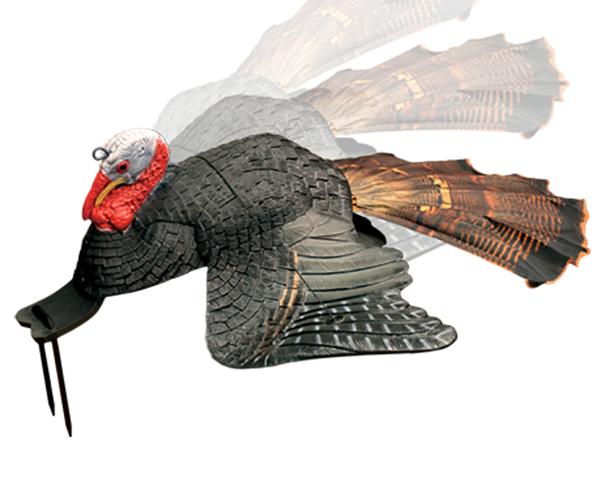
Early, Mid and Late Season Use and Fall Season Tactics
Knowing what decoys are effective early, mid and late-season is crucial to a successful set-up. Also, knowing the birds you are hunting and being able to read the bird’s temperament is helpful but this is not always possible. In early spring, when toms are still working on their pecking order, a jake or tom decoy and several hens will usually bring in a more dominant bird or a dominant jake that thinks he is spry enough to hold his ground. Keep in mind that in early season some birds, even mature birds, can be intimidated by strutting decoys until breeding season reaches its peak.
In early season, when the breeding cycle is starting to heat up, set-up a flock of feeding and walking hens to draw the attention of toms. Using several hens is enticing to the tom because it equals better breeding odds, in turn this will increase your odds–but placement is crucial. If you know what direction the tom will be traveling from, try to put the flock on the opposite side where the tom will have to cross in front of the shooter to get to the hens.
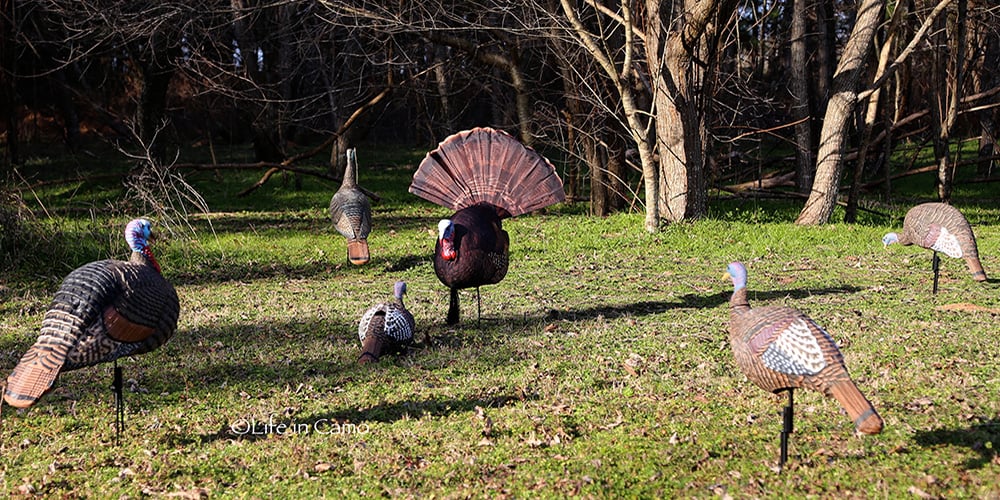
Several scenarios will work well mid-season because this is when the breeding cycle is usually at full peak and toms/jakes are hormone driven and full of aggression. Using several jake decoys with several hen decoys attracts dominant birds or mature birds that are feeling amorous. Often the pecking order has been established and the mature or trophy tom looks at this set-up as a threat. Using a full strut tom/jake decoy with a few hens is also very effective during mid-season and will usually draw the attention from both submissive and dominant birds as if “an open invitation to the party.”
A late season scenario could be a mature tom or the trophy tom that you have been hunting may be too exhausted from chasing and breeding hens to commit to the full strut set-up. It is also not likely that toms/jakes will be as aggressive late season since most hens are out of the breeding mode and setting on nests. Using a lone hen or a pair of hens can often spark some interest during late season hunting.
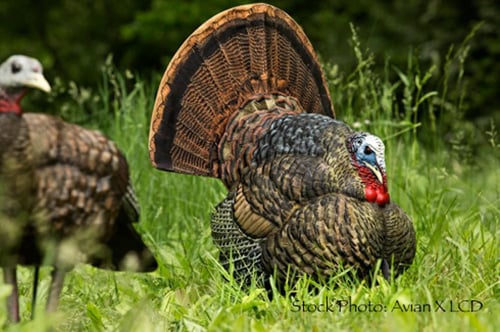
In the fall, using several hen decoys is very effective. Typically a hunter can be successful in the fall by busting up a flock of birds, then set out some decoys and call the birds back together using an assembly yelp—a long series of 15-20 yelps in a row-much longer than you hear in the spring.
Patterned Birds and Hunting Pressure
The two main reasons the use of a quality decoy set-up is often unsuccessful are patterned birds and hunting pressure. If you have patterned birds; basically those birds that you know what they do practically every day– where they fly down, where they feed and where they travel–you do not need to place decoys. Placing decoys on patterned birds may very well change their course if you add decoys in their territory. The other scenario is with educated birds from a lot of hunting pressure. Educated birds are usually birds that have had a run-in or two with a decoy setup and the results were shots fired at them that they were lucky enough to wrangle out of. These missed opportunities cause birds to become cautious and wary of motionless decoys.
Decoy Placement
Calculating the right distance to place the decoys and the precise place often takes a little science. How close or how far is totally dependent on the reliability of your weapons range and pattern with the shotgun, choke and shell combination you are using. What would be an ethical down range shot for one hunter and weapon may be totally different for another. It all boils down to the hunter’s experience and the weapon’s limitation. Typically in a shotgun scenario, you do not want to place the decoy less than 15 yards or further than 35 yards. This buffer is great for those toms that want to hang-up the last ten yards allowing the hunter to still have an ethical shot at that distance. Some hunters will not set the decoy up less than 20 yards because of the tightness of their weapons patterns; it would not take but a bobble from the tom for the shot to clean miss at that distance.
Positioning the decoy and shooter relevant to decoy is just as important as the distance it is placed from the hunter. Some tips that have been proven time and time again are setting the decoy up where you want to take the shot and keeping in mind that you do not want the bird to be in the direct line of sight of the shooter as it is working its approach to the decoy. A hunter runs the risk of getting busted for moving because it is already hard to move with a tom in view without it seeing you, but near impossible when it is starring right at you because you are in the line of site directly behind the decoy. If you know what direction the birds will be traveling from, try to set the decoys up where the bird will have to cross in front of you to come to the decoy. The tom typically focuses their attention and keen eyesight on the decoy, which allows for a very small amount of movement or concealment if you are perfectly still.
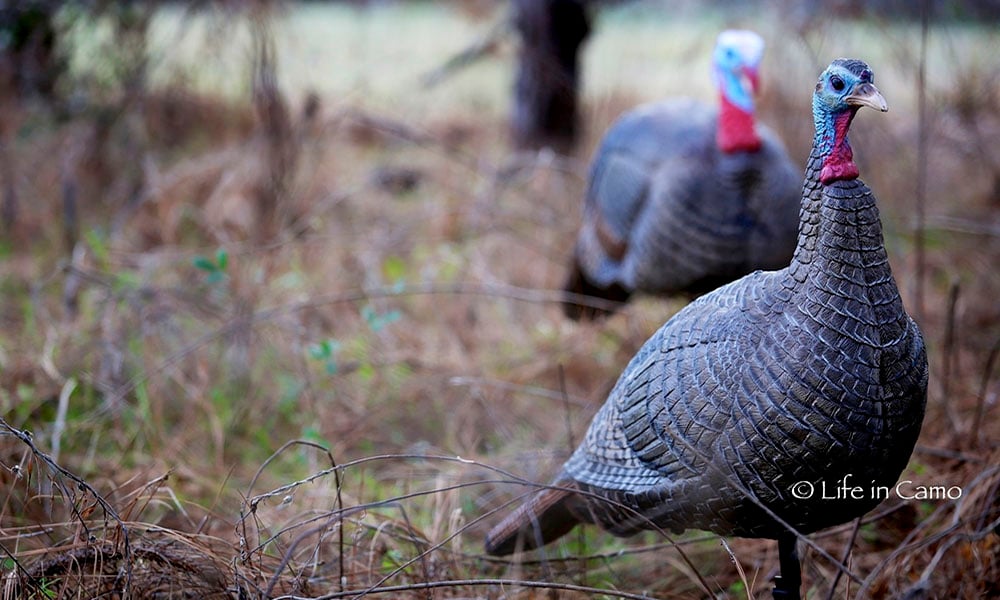
If there is no option but to set-up decoys in a manner that the tom could approach from a direction directly in front of the hunter, with the hunter in the direct line of sight upon the birds approach, using a small blind such as the Flambeau Mad Max Blind or making a natural blind from a couple cut saplings laid out in front of the hunter is very effective. It is often very successful to refrain from calling or keep calling to a minimum if a bird is committed and coming into the decoy set-up for the reason that hens in the wild are always quiet, outside of feeding purrs and contentment chatter, when toms are approaching.
Keep in mind that sometimes a tom will get “locked-in” on a decoy and will close the ground quickly, often with other toms/jakes in tow and everything unfolds in a hurry so it is important to be ready and in a position to take the shot. Other times a tom may “hang-up” from where he first spots the decoy and parade in full strut trying to get the amorous hens to come to him because the nature of the game is to have the hens come to the strutting tom. The latter scenario extremely limits the amount of movement a hunter can make because that tom is on high alert for any movement coming into the decoys. If you experience the same scenario with a certain tom hanging up, you can set the decoys up behind you in a visible manner at 15 to 20 yards and call the bird in enough to shoot. It is also effective if you have a caller that can sit behind the hunter at the same distance and call. The tom will have to make its way to the decoy and it often puts the tom at a distance the hunter can take an ethical shot.
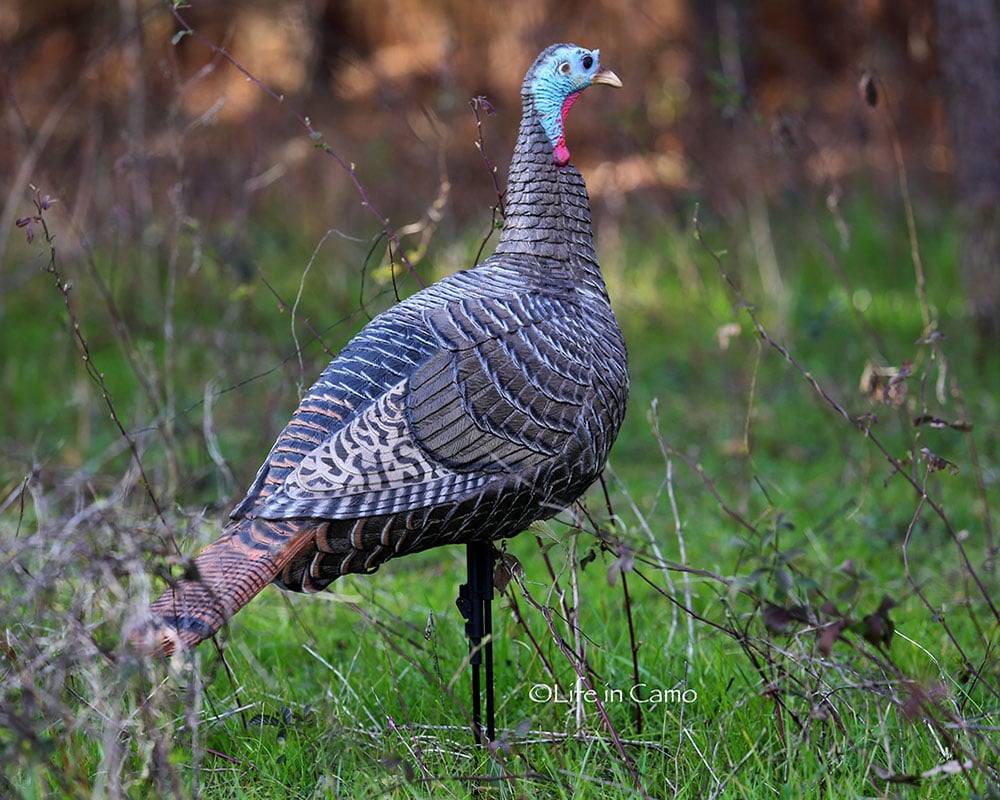
There are a variety of ways that you can place your decoy set-up but as mentioned above, using the time of the season to your advantage will prove more successful than just using the same setup time and time again. I will discuss a few decoy setups and strategies that have proven successful for many of the diehard turkey hunters that I know well.
Proven Strategies and Tactics
Always try to create realistic looking flocks. Spread your birds out and position them in the same direction as they would naturally travel or feed. Be sure to arrange your decoys where they are not bunched up in a tight group; a bunched up flock resembles a sign of insecurity or alertness to the surrounding area making approaching birds leery and often keeping them from coming into shooting range.
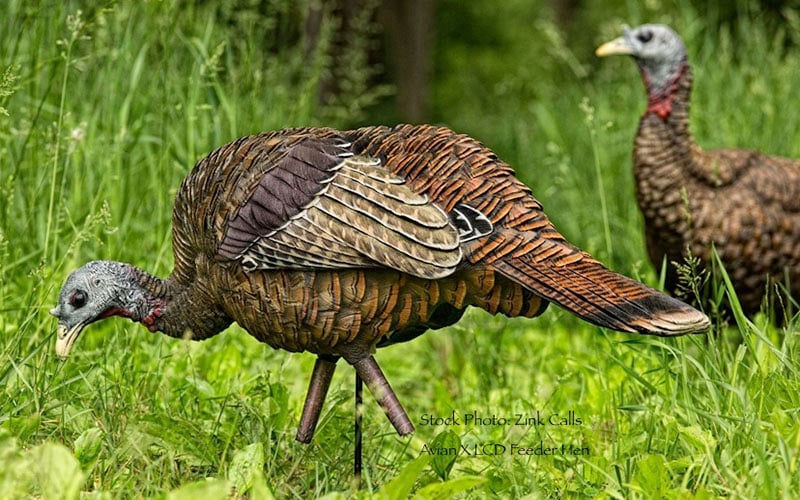
As mentioned, but worthy of reminding, keep in mind that using a full strut mature tom can often be a disadvantage by causing a non-dominant mature bird or one that has been whooped by another Jake/tom to flee the area in fear of another fight. Use your experience with the interactions you have had with the birds in your hunting area and don’t be hesitant to change your set-up in another area on the same day’s hunt if you get another opportunity.
When using a half-strut or full-strut jake/tom and several hens, place the jake/tom facing you with the hens feeding around it, usually a mature gobbler will circle the jake decoy to get in the jake’s line of sight to show dominance, giving the hunter a closer shot. If using only hen decoys and/or a breeding hen, place the hen decoy facing away from the hunter, a tom is going to circle a hen decoy positioning to mount her from behind.
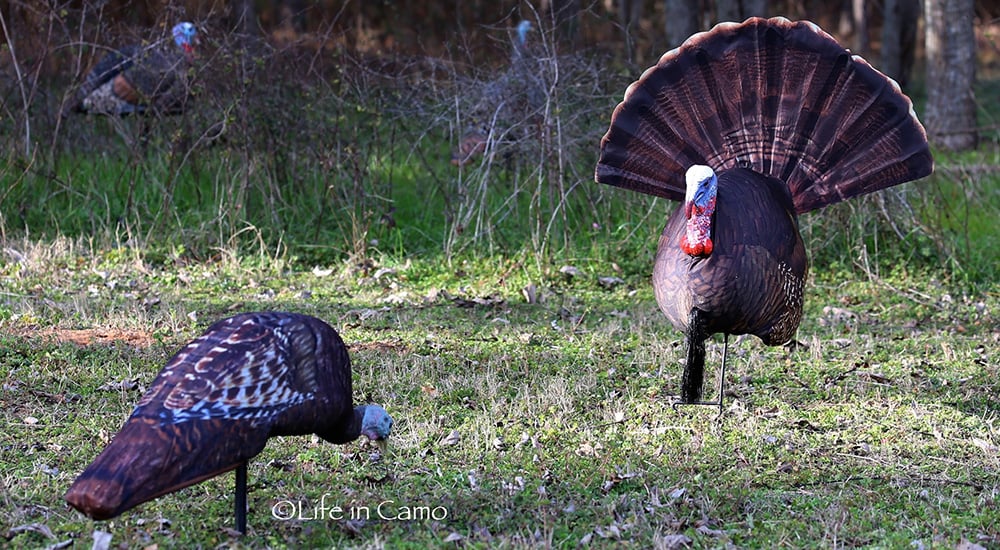
When using a decoy set-up with a tom/jake and several hens, always place the tom/jake decoy where you want to take the shot and spread the hens out for a relaxed look. This set-up will allow the live tom to physically engage with decoy or engage with a hen at a safe distance. Set the hen decoys at 5, 7, or 10 steps away opposite where you think the live tom will come from.
If you have the choice of tails on strutting decoys, using a jake fan resembles a more submissive bird and is more likely to bring in mature toms. Often a mature tom will see the strutting jake as an intruder poaching on his flock of hens.
A flock of hens is not only a set-up that is effective early season; it can also be used to entice a boss hen to come to the flock mid-season often bringing that boss tom in tow with her. Be cautious of too much calling in this situation.
Motion-Generated Decoys
Most decoys are designed to move freely in the wind to give the decoy a more lifelike appearance but there are decoys and products you can buy that evoke motion in decoys. Some hunters have even used fishing line that runs back to them that they can use to create movement. In most states, it is illegal to use decoys that are motion-generated by the hunter or other mechanisms so you will need to check the game regulations in the state that you plan to turkey hunt to see if motion generated decoys are legal before using them.
Safety Issues
It is important to employ extreme caution when using turkey decoys; especially when hunting public land. Always keep the decoys completely concealed in your turkey vest or a decoy bag when carrying them on public land. Decoy bags are also a great way to keep your decoys in good shape and to keep the stakes handy. Never set your decoys up where you could be in the direct line of fire of other hunters who may approach. Always be aware of your surroundings when using turkey decoys.
You don’t have to use decoys to harvest turkey but if you are going to use them, and have the time to set them up, make sure you are using them correctly and to your advantage. Deciding which decoys are right for your hunting situation can literally leave you lying awake the night before the hunt and often changes several times in your head before a stake is ever placed in the ground. Remember to be flexible for the time of season and adjust your tactics accordingly. You will often find what was successful in one hunting scenario may not work at all in another–learning from every failure can result in success on a regular basis.
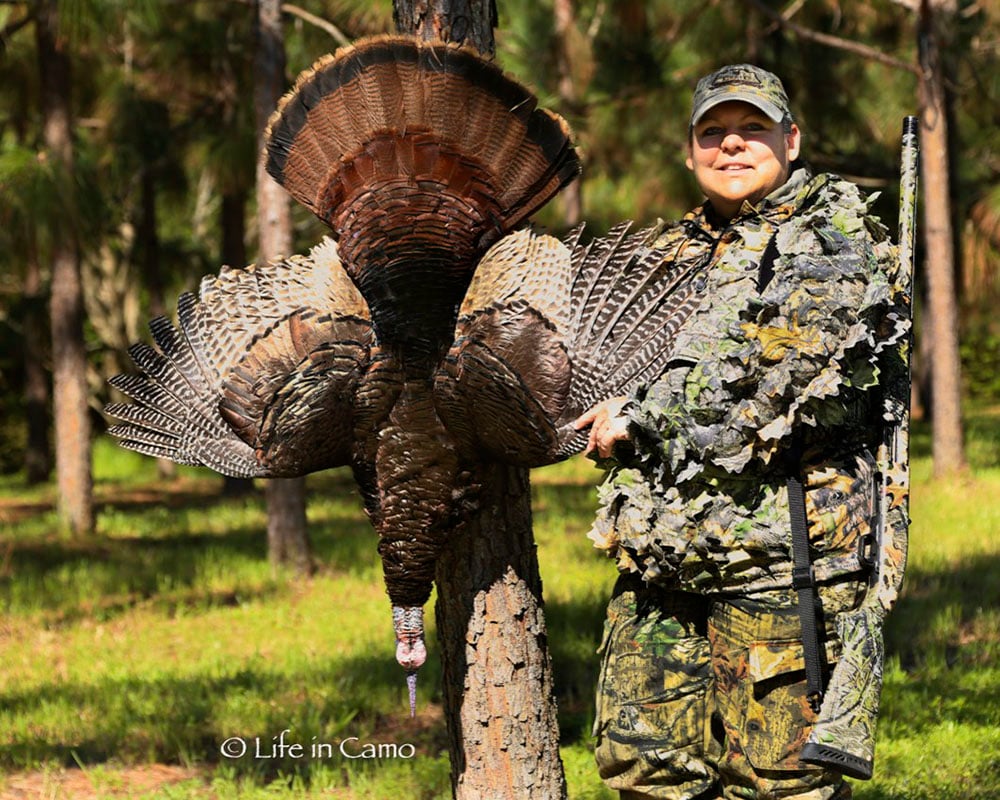
All logos and/or photos are the property of the copyright owner and used in this article as reference; not for monetary gain. See the copyright information in the photo caption for ownership.

